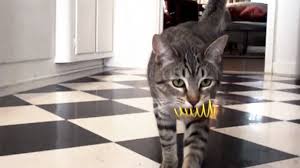An indoor cat benefits greatly from hunting smaller toys. This is because they more closely resemble the type of prey a house cat might hunt—bugs, moths, or baby mice. Unless a cat was taught to hunt large prey by an adult cat, she will not hunt adult mice, much less birds, chipmunks, or rats. These prey take skills that an untaught cat simply does not have. So provide her with smaller toys.
Build confidence
Hunting smaller toys is the best way to build an indoor cat’s confidence and contentment. Because these toys are not scary, a cat is more apt to attack them. And a successful hunt builds confidence. Also these toys are inexpensive—a bag of small toy mice, small springs, or plastic rings is quite affordable. I’ve seen so many cats play for 10 minutes or more with a toy spring made for cats. A simple toss by the owner can double or triple the amount of play time. You can even make small toys from scraps of paper or the plastic rings from milk jugs.
Keep Interest
Novelty will keep your cat interested. Move these toys to different parts of your house. Keep many of them in a shoe box, and alternate which ones are scattered about. To be most enticing, have the toy half-hidden. Or perch the toy on a shelf or kitty condo, on the brink of falling off. Your house probably lacks movement when you are not there. If you set up toys to easily fall it will add excitement to your cat’s time without you.
You may also enjoy my article on active
kittens.
Patience Fisher owns Patience for Cats LLC, a cat behavior business based in Pittsburgh, PA. She is Associate Certified by the International Association of Animal Behavior Consultants. She holds a Bachelor’s of Science in Biology, a Diploma of Feline Behavior Science Technology, and is a certified veterinary assistant. Visit her on Facebook at Patience for Cats.


Comments 1
Thanks for the tips.I love the idea of using smaller toys to help my cat build confidence